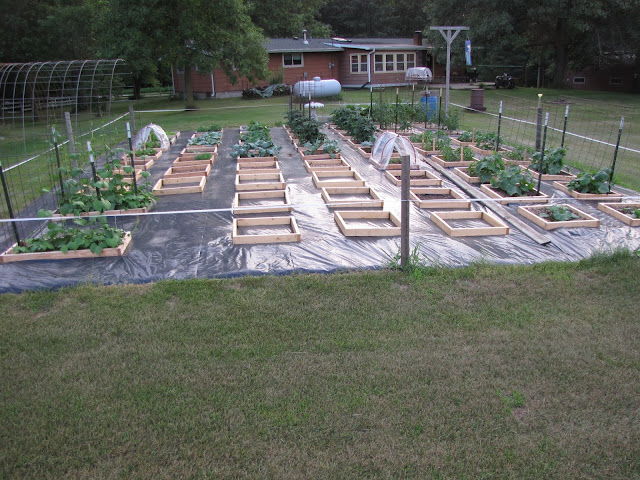 |
Rick's Garlic Minibeds in early June
(click photos for larger views) |
Back in March of this year I posted here about Rick's Amazingly Beautiful Wisconsin Minibed Garden. The photos of Rick's garden in that post were from the 2018 gardening year. But the photo above is from Rick's 2019 Minibed garden. It was sent to me in June with the following e-mail...
.
Hi Herrick,
I just thought I’d drop you a line and update you on my mini-bed experience.
I have just about all my planting done, except for carrots and I plant those the first part of July. We had a cool spring here. We had a few 80 degree days last week and now we are back to the low, to maybe mid 70’s this week. We didn’t have any 80 degree days in May, so things are kind of off to a slow start this year. That’s OK with me though. I don’t mind working on the cool days. When the temps get in to the upper 80’s to around 90 degrees with a 65-70 degree dew point, I start to melt. I don’t work so well outside then.
Last year was my first year with a mini-bed garden and I cracked the soil as I prepared the beds for planting. I didn’t notice anything different, or unusual when I cracked the soil.
This year as I cracked the beds to prep them, I got a surprise. My four tined potato fork that I use slipped in to the soil in the beds with hardly any effort. At most, I gave the fork handle a little push. The soil was so soft and friable I was amazed. I kept the beds mulched with leaves over the winter and with the amount of snow we had, I thought the beds would have settled, or packed down some. They did not.
Also this year after I cracked the beds, I added the amendments, then worked up the top 2”-3” of soil to mix them in. My thought is that some of the amendments will mix a little deeper in to the soil. Also instead of breaking up and mixing the top few inches of soil then adding the amendments and then mixing again. I added the amendments right after I cracked the soil and then mixed.
Last year I wrote to you and told you about my garlic patch failure. Out of 150 cloves planted I got one plant. When I checked it out later last spring I think all of the garlic cloves rotted except that one. When I searched the bed I couldn’t find any trace of the garlic cloves.
Last October I planted garlic in mini-beds in my lower garden. I amended each bed with alfalfa meal, kelp meal and dry screened chicken manure. I will have garlic this year. Actually I think it’s the best garlic I have grown. The leaves are tall and the stems are thick. I’ve attached a few pictures of the beds. I noticed yesterday that the scapes are just starting to emerge from the top leaves.
Take care.
Rick from Wisconsin
.
Here's another photo of Rick's garlic beds in early June. No weeds. Beautiful plants.
I never got around to posting those photos and Rick's comments back in June. So I contacted him a few days ago and asked if I could get some current pictures. These are the garlic beds on July 9th...
Those beautiful garlic beds are almost ready to harvest. If that's not some great gardening inspiration, I don't know what is.
If you have not yet seen my YouTube videos about Minibed garlic, here they are...
And if you are not familiar with cracking the soil...




































